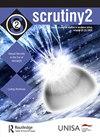In Search of the “Goodlife”: Border Crossing and Agency in Luis Alberto Urrea's Into the Beautiful North and Graciela Limón's The River Flows North
IF 0.1
0 LITERATURE
Scrutiny2-Issues in English Studies in Southern Africa
Pub Date : 2019-01-02
DOI:10.1080/18125441.2019.1647449
引用次数: 1
Abstract
ABSTRACT This article explores representations of complex diasporic subjectivities that resist, or attempt to resist, obsolete nationalist notions of citizenship and identity by crossing the US– Mexico border (and, in so doing, crossing other intangible borders) in search of a better life. Two examples of border literature, Luis Alberto Urrea's Into the Beautiful North (2009) and Graciela Limón's The River Flows North (2009), have been selected for analysis. These texts, in describing various diaspora spaces—to enlist Avtar Brah's term (Cartographies of Diaspora. London: Routledge, 1996)—also examine how those who do not migrate are affected by migration. In Writing the Goodlife: Mexican American Literature and the Environment (Tucson: University of Arizona Press, 2016), Priscilla Solis Ybarra reveals how the past century and a half's Mexican-American literature contains valuable new approaches to creating and sustaining new forms of transnational relations between humans, and ecologically sound relationships between humans and nature. In many ways, the primary texts selected can be viewed as examples of “goodlife” writing because they highlight the socio-political as well as the environmental and economic crises in Latin America which force impoverished Mexicans to migrate north. As examples of border literature, these texts add a twist to “goodlife” writing by describing the border region as a hazardous diaspora space, and by emphasising the agency of the migrant characters who attempt to embrace their liminality and multiply located identities as they make the perilous journey across the border.寻找“美好的生活”:路易斯·阿尔贝托·尤里亚的《走进美丽的北方》和格雷西拉·利蒙的《河流北流》中的跨界与代理
摘要本文探讨了复杂的流散主体性的表现,这些主体性通过跨越美墨边境(以及在这样做的过程中,跨越其他无形的边界)来抵抗或试图抵抗过时的民族主义公民身份和身份观念,以寻求更好的生活。选取了路易斯·阿尔贝托·尤里亚的《走进美丽的北方》(2009年)和格雷西拉·利蒙的《河流向北流动》(2009)这两部边境文学作品进行分析。这些文本在描述各种散居空间时——借用了Avtar Brah的术语(《散居地图》,伦敦:Routledge,1996)——也考察了那些不移民的人是如何受到移民的影响的。Priscilla Solis Ybarra在《书写美好生活:墨西哥裔美国人的文学与环境》(图森:亚利桑那大学出版社,2016年)中揭示了过去一个半世纪的墨西哥裔美国人文学如何包含创造和维持人类之间新形式的跨国关系以及人类与自然之间生态良好关系的宝贵新方法。在许多方面,所选的主要文本可以被视为“美好生活”写作的例子,因为它们突出了拉丁美洲的社会政治以及环境和经济危机,这些危机迫使贫困的墨西哥人向北移民。作为边境文学的例子,这些文本通过将边境地区描述为一个危险的散居空间,并通过强调移民角色的能动性,为“美好生活”写作增添了一个转折点,他们试图在穿越边境的危险旅程中拥抱自己的极限,并扩大自己的身份。
本文章由计算机程序翻译,如有差异,请以英文原文为准。
求助全文
约1分钟内获得全文
求助全文
来源期刊
CiteScore
0.50
自引率
0.00%
发文量
10
期刊介绍:
scrutiny2 is a double blind peer-reviewed journal that publishes original manuscripts on theoretical and practical concerns in English literary studies in southern Africa, particularly tertiary education. Uniquely southern African approaches to southern African concerns are sought, although manuscripts of a more general nature will be considered. The journal is aimed at an audience of specialists in English literary studies. While the dominant form of manuscripts published will be the scholarly article, the journal will also publish poetry, as well as other forms of writing such as the essay, review essay, conference report and polemical position piece. This journal is accredited with the South African Department of Higher Education and Training.

 求助内容:
求助内容: 应助结果提醒方式:
应助结果提醒方式:


